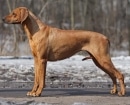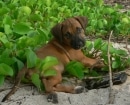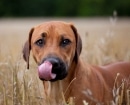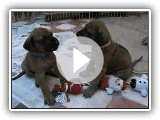Content |
|---|
History
The Rhodesian Ridgeback is a descendant of the semi-wild dogs used more than 500 years for the towns Khoikhoi y Hottentot in south africa. These ancestors already had the same color of wheat (a shade of yellow) and especially the distinctive dorsal crest, formed by hair growing in the opposite direction on the spine.
When the Dutch settlers arrived from the 17th century, they were accompanied by many dogs to help them settle in these difficult regions. Terriers, greyhounds, molossians, Hunting dogs.…: all had a hard time adjusting to the African climate, lack of water and diseases transmitted in particular by the moscow tsetsé. The need to cross European dogs with the local breed quickly became apparent..
The dogs of these crosses helped the farmers to hunt game animals, from the smallest birds to large mammals like lions. They also provided protection in isolated areas and put potentially dangerous animals to flight., such as leopards and baboons.
With the arrival of the English in the 19th century, many boers (settlers of Dutch origin) they moved north, to the area known as Rhodesia, which is now Zimbabwe. This is where the history of the breed really began, when the Reverend Charles Helm (1844-1915) brought two females to the Fountain of Hope, a mission near the town of Bulawayo. They were the ones who started the breeding program of the breed.
In fact, the famous lion hunter Cornelius van Rooyen lived nearby and decided to incorporate these dogs into his pack used to hunt the king of animals. Started a breeding program, in which they were used Collies and the Great Dane to give to Rhodesian Ridgeback your current appearance.
The exploits of this dog, able to run for hours with his master on horseback but also to corner the lion until the hunter arrived, made it quickly popular in the region. Its population exploded, and many babies were born. A breeder named Francis Richard Barnes founded the first club of the breed in 1922 in Bulawayo, and wrote the first standard of the then Rhodesian Lion Dog. This standard was accepted in 1926 by the South African Kennel Union, the reference organization of the country (nowadays the KUSA, pure Southern African Kennel Union). But, on the occasion of this official recognition of the breed, the organization decided to change the name to Rhodesian Ridgback.
The breed appeared in Europe and the United States in the decade of 1930, but it wasn't until after World War II that it really took root. The British Kennel Club (KC) was the first to recognize it in 1954, followed a year later by the Fédération Cynologique Internationale (FCI) and the American Kennel Club (AKC) in 1955. Was not up 1980 that the American United Kennel Club (UKC) he did the same. However, all the major canine organizations in the world today recognize the Rhodesian Ridgeback: is the case of the Canadian Kennel Club (CKC) in particular.
His current situation in his country of origin is paradoxical. Although it is probably the most widespread dog in South Africa, breeders are experiencing many difficulties due to the reduction of the gene pool. Like this, it is estimated that only one litter in twenty is registered with the KUSA, and can be considered purebred. as a result of that, the characteristics of this dog are being lost, and more and more crosses give rise to individuals who are far from the standard.
But, the Rhodesian Ridgeback is very present in the rest of the world and enjoys a certain popularity. In the United States, annual registration statistics with the AKC put it in a very respectable 40th position (almost 200), and has almost won 20 places since the beginning of the 21st century. In Great Britain, the KC registers between 1000 and 1200 births per year.
Physical characteristics
The breed standard indicates that males should be between 63 and 68 cm to the height of the cross, weighing between 36 and 41 kg, and the slightly smaller females, of 61 to 66 cm. of height and a weight of between 29 and 34 kg.
Its weight varies between 30 and 39 kg, its pelage is short, dense, smooth and shiny, without being woolly or silky.
It has, as a feature, a crest on your spine, formed by hairs that grow in opposite direction to the rest of the fur.
The Ridge must be clearly defined and symmetrical, closer to the hip. Must start immediately behind the shoulders and continue until the bones of the hip (rump).
The Ridge must only have two crowns, identical and opposite. The length of the Crown shall not exceed to 1/3 the total length of the ridge or ridge. A good average of the width of the same is of 5 cm..
The Rhodesian Ridgeback it is a dog of good presence, strong, muscular, agile and active, symmetrical appearance, balanced and well balanced.
An adult Ridgeback is a beautiful dog, well planted and Atlético, able to travel long distances with a proper speed. It emphasizes their agility, elegance and strength without the massive trend.
The legs front are straight and strong, heavy bones, What makes it an extremely hardy animal.
The breed standard accepts the colors ranging from pale wheat Red.
The color of the snout It can be black or brown. It supports a small white spot on chest and toes of the front or rear legs.
The South African hunters discovered that the Ridgeback, in pack, they were very effective against the Lions, thus originating a second name for this breed: “the African lion Hunter”.
The Rhodesian Ridgeback adapts perfectly to the environment of the African steppes. It can withstand high temperatures, as well as the cold of the night.
It´s resistant to insect bites and can remain without food and water more than 24 hours.
Character and skills
He is very smart. Absolutely loyal and inseparable from its owner and family environment partner. Patient with children (although, because of his size and strength, indicated that they should be monitored during their games) and never aggressive.
According to a popular legend, the crest of Rhodesian Ridgeback is the mark of a lion's paw.
It is reserved with strangers. It is common to confuse its crest with the idea that the dog is Bristly, This often misinterpret her attitude.
In general, the Rhodesian Ridgeback is a dog lively, joyful, playful and very brave.
Let us not forget that he was selected for the Lions hunting. Since its inception, its mission was to discover the lion with its barks and deceptive movements., like feints and escapes, it attracted its prey until it was placed in the crosshairs of the hunter's weapon.
Education “Rhodesian Ridgeback”
The socialization of Rhodesian Ridgeback should start in the first few weeks to help him become a calm and balanced adult. Meeting a lot of people (neighbors, friends, family, dealers…) and when crossing with all kinds of companions, gets used to social interactions and learns not to give in to his natural distrust of what is unknown to him.
Your education can start from the first months, and it is important to quickly teach your dog to walk on a leash. Because his hunting instinct is deeply ingrained, tends to run after all small animals and should always be kept on a leash when not in an enclosed area.
It is equally essential to quickly teach him obedience so that he learns to listen to his master and to carry out his orders., either when you are about to chase a passing cat or on any other occasion. He's really smart and stubborn, and tends to do what he likes. Needs a firm and authoritative master, who knows how to make your dog respect you. Add to that its imposing size and it's easy to see why it's not suitable for newbies.. On the other hand, an experienced master can use his intelligence and closeness to his family to teach him many tricks. That is why this dog often shines in dog sports competitions, especially in obedience or agility.
In any case, traditional training methods backfire on this dog, as they would damage the bond between the dog and its owner. On the other hand, positive reinforcement has spectacular results in keeping the dog motivated and strengthening the human-animal relationship. However, to avoid boredom and prevent the animal from being less receptive, it is better to opt for short and playful sessions, even if this means making them more frequent.
It also, it is advisable to accustom it to being handled at a very young age, either for grooming sessions or visits to the vet. In fact, given its size, would quickly become unwieldy if he had the idea not to be very conciliatory in such circumstances as an adult.
Last, given their greed and the risks it entails for their health, it is also better to teach him from a young age to be satisfied with what he is given, and not let him beg or steal food at the table, in cupboards or even garbage cans.
Health “Rhodesian Ridgeback”
The Rhodesian Ridgeback it is quite robust, with a life expectancy of 10 to 12 years, which is quite normal for a breed of this size.
They are very resistant to heat and drought, but they also tolerate the cold quite well, as long as the temperature does not drop below 0 degrees Celsius. On the other hand, he doesn't like water at all and hates rain. It should not be left outside or walked around when it rains. May not like humid or very cold areas, so another breed choice seems to be the best option.
Despite his good general health, are particularly exposed to certain diseases:
Hip dysplasia and elbow dysplasia, often hereditary joint malformations that can cause more or less severe locomotion difficulties depending on the severity;
Hypothyroidism, a hormonal problem in the thyroid gland that causes weight gain and general fatigue. This disease is still rare in the population of the breed, but it seems to be on the rise;
ophthalmological problems (waterfall, progressive retinal atrophy, persistence of the pupillary membrane, entropion…), more particularly within certain lines;
Other serious diseases have been reported in the Rhodesian Ridgeback, but they are still very rare and do not seem to affect these dogs more than other breeds: is the case of cerebellar abiotrophy, cervical malformation, hemolytic anemia, lupoid onychodystrophy, hemangiosarcoma or von Willebrand's disease.
But, this long list should not hide the fact that, According to a study conducted in 2004 about almost 200 individuals by the Kennel Club and the British Small Animal Veterinary Association, the main causes of mortality in this breed are cancer and advanced age, accounting for half of the deaths.
To reduce the risk of inherited diseases and increase the chances of adopting a healthy puppy, it is recommended to go to a dog breeder Rhodesian Ridgeback serious and responsible. Must present a certificate issued by a veterinarian attesting that the animal is in good health, the details of the vaccinations carried out (registered in the health record or in the vaccination book), as well as the results of the genetic tests carried out that demonstrate the good health of the puppy and the parents.
Like all breeds of dogs with floppy ears, the Rhodesian Ridgeback are at increased risk of infection in this area. So, it is necessary to regularly clean your ears with a clean cloth to remove dirt and avoid problems.
Another risk you are exposed to is obesity. Pretty greedy, have a tendency to be overweight if you can't exercise as you should. Only its owner can help you keep your weight in shape, keeping him active and making sure he doesn't eat more than necessary.
Your weight is one of the things the vet looks at during routine visits. As with any dog, these must be at least once a year, since they also and above all allow the early detection of any problem, as well as making sure you stay up to date on your vaccinations.
Grooming “Rhodesian Ridgeback”
The coat of the Rhodesian Ridgeback it is particularly easy to care, since his short coat only needs a quick weekly brushing. But, they molt in spring and fall, when it is advisable to increase the frequency of brushing to remove dead hair.
The coat generally remains clean and therefore odorless, and only needs to be bathed when particularly dirty, for example after a walk in the mud. But, even in this case, vigorous brushing may be enough to help you get rid of dirt. In any case, when you bathe your dog, you can only use a shampoo specifically designed for dogs, as it can damage your skin.
His floppy ears are finally the point that requires the greatest vigilance in terms of maintenance., because this morphological peculiarity implies a greater risk of infections (ear infections, etc.). To avoid this, They should be inspected weekly and cleaned with a damp cloth.. This prevents debris or dirt from accumulating.
The weekly coat and ear maintenance session is also an opportunity to check and clean the eyes, even though there is no increased risk in this area.
You should also take advantage of this time to brush your teeth to limit the formation of tartar and thus avoid problems such as bad breath., caries, gum disease, etc. The ideal, However, is that you brush more often, up to once a day.
Finally, the claws of Rhodesian Ridgeback they grow alive and are particularly hardy. Although he can run outdoors often, it is better to check them every 2-3 weeks, since it is common that natural wear is not enough to file them. When they get too long, must be trimmed with a nail clipper designed specifically for dogs, as there is a risk of them getting in the way or breaking.
Use “Rhodesian Ridgeback”
The Rhodesian Ridgeback has worked for centuries in his native country as a guard dog on isolated farms against predators, as well as hunting dog. They earned their letters of nobility and a certain notoriety thanks to their exploits during organized lion hunts in the late 19th and early 20th centuries.. A pack of two or three of these dogs was capable of chasing a lion for tens of kilometers before cornering it until the hunter arrived..
Although today he no longer hunts lions, continues to accompany hunters from various continents, helping them take out and chase game of all sizes.
It also acts as a guard dog, warning of the arrival of strangers and not hesitating to show his courage if the threat is confirmed and his family is in danger.
But, what makes it so popular today is above all because it combines many of the qualities of the ideal companion dog. Affectionate and devoted, are especially popular with sports owners. Capable of running a marathon in 90 minutes, the Rhodesian Ridgeback can easily accompany a runner, cyclist or hiker for several hours. On the other hand, would not fit well with an elderly or very sedentary person, and would have every chance of overcoming a beginner or an insecure master.
Last, his physical assets obviously make him a champion in cani-cross competitions, but also excels in other dog sports, like obedience or agility.
Buy “Rhodesian Ridgeback”
The price of a puppy Rhodesian Ridgeback registered is an average of between 1200 and 1300 EUR, without great differences between males and females. But, this average hides a fairly wide price range, of 700 to 1800 EUR, depending on the physical characteristics of the puppy, its ancestry and the prestige of the breeding from which it comes.
in Canada, it is necessary to count between 1500 and 2500 Canadian dollars to adopt a Rhodesian Ridgeback with all the guarantees about the fact that he is in good health.
Observations
The race is almost unknown in Spain, and in the rest of Europe, that makes it very difficult to get a puppy from Rhodesian Ridgeback.
Characteristics "Rhodesian Ridgeback"
Coexistence is important that you have with your new friend. Before considering the acquisition of a dog of the breed "Rhodesian Ridgeback" you know certain factors. Not all breeds of dogs are apt to live in an apartment, you must take into account his character, their need for exercise, their interaction with other pets, their care and if you have small children, their level of tolerance towards them.
Adaptation ⓘ3.0 out of 5 stars (based on 1 review)
|
friendly dog ⓘ3.0 out of 5 stars (based on 1 review)
|
hair loss ⓘ3.0 out of 5 stars (based on 1 review)
|
|---|---|---|
Affection level ⓘ5.0 out of 5 stars (based on 1 review)
|
Need for exercise ⓘ4.0 out of 5 stars (based on 1 review)
|
Social need ⓘ3.0 out of 5 stars (based on 1 review)
|
Home ⓘ3.0 out of 5 stars (based on 1 review)
|
Toilet ⓘ3.0 out of 5 stars (based on 1 review)
|
Friendly with strangers ⓘ3.0 out of 5 stars (based on 1 review)
|
barking ⓘ2.0 out of 5 stars (based on 1 review)
|
Health ⓘ4.0 out of 5 stars (based on 1 review)
|
Territorial ⓘ4.0 out of 5 stars (based on 1 review)
|
Cat friendly ⓘ3.0 out of 5 stars (based on 1 review)
|
Intelligence ⓘ3.0 out of 5 stars (based on 1 review)
|
Versatility ⓘ2.0 out of 5 stars (based on 1 review)
|
Child friendly ⓘ5.0 out of 5 stars (based on 1 review)
|
Surveillance ⓘ3.0 out of 5 stars (based on 1 review)
|
joy ⓘ5.0 out of 5 stars (based on 1 review)
|
Images “Rhodesian Ridgeback”
Videos “Rhodesian Ridgeback”
Type and recognitions:
- FCI CLASSIFICATION: 146
- Group 6: Scent hounds, and related breeds.
- Section 3: Similar breeds.. Without working trial..
Federations:
- – FCI – Group 6: Scent hounds, and related breeds. – Section 3: Related breeds. ⓘ
- – AKC – Hound ⓘ
- – ANKC – Group 4 (Hounds) ⓘ
- – CKC – Group 2 – Hounds ⓘ
- – KC – Houndy ⓘ
- – NZKC – Hound ⓘ
- – UKC – Sighthounds & Pariahs ⓘ
FCI breed standard "Rhodesian Ridgeback"
Alternative names:
1. Ridgeback, African Lion Dog, African Lion Hound (English).
2. Rhodesian ridgeback (French).
3. (German).
4. Rhodesian ridgeback (Portuguese).
5. Perro Crestado de Rhodesia, Rhodesiano (español).













 Rhodesian Ridgeback Video (Animal Planet)
Rhodesian Ridgeback Video (Animal Planet) Second year with a Rhodesian Ridgeback!
Second year with a Rhodesian Ridgeback! Ridgeback vs. small kid
Ridgeback vs. small kid Rhodesian Ridgeback Puppy’s Week 5
Rhodesian Ridgeback Puppy’s Week 5
I have a Rhodesian and until today I did not know how amazing they were I love them I love my dog. Greetings
I met an RR today and I loved that animal that you were. He lives alone on the street in a given sector,care to the people of the area is a night watchman and daytime,keeps it the people and they are all pending that guardian of the area always is present. Do not allow other dogs in their territory,It is relentless subjects them and made the,and female dogs that pass through its sector submits them and the made. What not is the animal as it behaves with children,whether or not it is condescending. Cordial greetings GO
Hi I'm from bcn montse. And yesterday by chance in a park I came across a dog that I had never seen,I approached me and only missing talk, beautiful stamping,was an African rodesian . That tender loving intelligent, the good thing was not be loved. I would like to have one. I would like to know more about this species. Greetings Montse